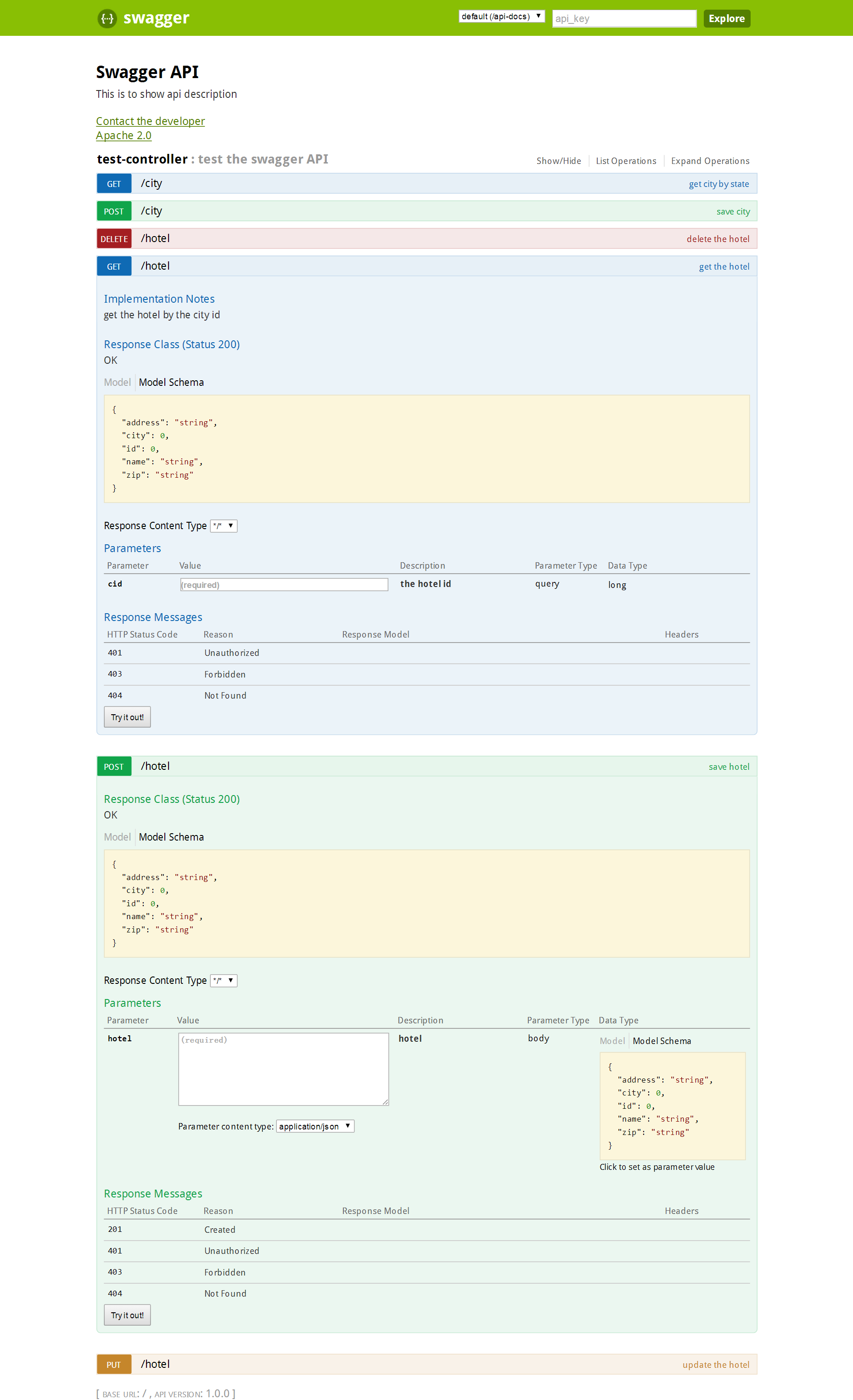初衷
记得以前写接口,写完后会整理一份API接口文档,而文档的格式如果没有具体要求的话,最终展示的文档则完全决定于开发者的心情。也许多点,也许少点。甚至,接口总是需要适应新需求的,修改了,增加了,这份文档维护起来就很困难了。于是发现了swagger,自动生成文档的工具。
swagger介绍
首先,官网这样写的:
Swagger – The World's Most Popular Framework for APIs.
因为自强所以自信。swagger官方更新很给力,各种版本的更新都有。swagger会扫描配置的API文档格式自动生成一份json数据,而swagger官方也提供了ui来做通常的展示,当然也支持自定义ui的。不过对后端开发者来说,能用就可以了,官方就可以了。
最强的是,不仅展示API,而且可以调用访问,只要输入参数既可以try it out.
效果为先,最终展示doc界面,也可以设置为中文:
在spring-boot中使用
以前总是看各种博客来配置,这次也不例外。百度了千篇一律却又各有细微的差别,甚至时间上、版本上各有不同。最终还是去看官方文档,终于发现了官方的sample。针对于各种option的操作完全在demo中了,所以clone照抄就可以用了。
github sample源码
配置
1.需要依赖两个包:
<dependency>
<groupId>io.springfox</groupId>
<artifactId>springfox-swagger2</artifactId>
<version>${springfox-version}</version>
</dependency>
<dependency>
<groupId>io.springfox</groupId>
<artifactId>springfox-swagger-ui</artifactId>
<version>${springfox-version}</version>
</dependency>
第一个是API获取的包,第二是官方给出的一个ui界面。这个界面可以自定义,默认是官方的,对于安全问题,以及ui路由设置需要着重思考。
2.swagger的configuration
需要特别注意的是swagger scan base package,这是扫描注解的配置,即你的API接口位置。
@Configuration
@EnableSwagger2
public class SwaggerConfig {
public static final String SWAGGER_SCAN_BASE_PACKAGE = "com.test.web.controllers";
public static final String VERSION = "1.0.0";
ApiInfo apiInfo() {
return new ApiInfoBuilder()
.title("Swagger API")
.description("This is to show api description")
.license("Apache 2.0")
.licenseUrl("http://www.apache.org/licenses/LICENSE-2.0.html")
.termsOfServiceUrl("")
.version(VERSION)
.contact(new Contact("","", "miaorf@outlook.com"))
.build();
}
@Bean
public Docket customImplementation(){
return new Docket(DocumentationType.SWAGGER_2)
.select()
.apis(RequestHandlerSelectors.basePackage(SWAGGER_SCAN_BASE_PACKAGE))
.build()
.directModelSubstitute(org.joda.time.LocalDate.class, java.sql.Date.class)
.directModelSubstitute(org.joda.time.DateTime.class, java.util.Date.class)
.apiInfo(apiInfo());
}
}
当然,scan package 也可以换成别的条件,比如:
@Bean
public Docket api() {
return new Docket(DocumentationType.SWAGGER_2)
.apiInfo(apiInfo())
.select()
.apis(RequestHandlerSelectors.withMethodAnnotation(ApiOperation.class))
.build();
}
3.在API上做一些声明
//本controller的功能描述
@Api(value = "pet", description = "the pet API")
public interface PetApi {
//option的value的内容是这个method的描述,notes是详细描述,response是最终返回的json model。其他可以忽略
@ApiOperation(value = "Add a new pet to the store", notes = "", response = Void.class, authorizations = {
@Authorization(value = "petstore_auth", scopes = {
@AuthorizationScope(scope = "write:pets", description = "modify pets in your account"),
@AuthorizationScope(scope = "read:pets", description = "read your pets")
})
}, tags={ "pet", })
//这里是显示你可能返回的http状态,以及原因。比如404 not found, 303 see other
@ApiResponses(value = {
@ApiResponse(code = 405, message = "Invalid input", response = Void.class) })
@RequestMapping(value = "/pet",
produces = { "application/xml", "application/json" },
consumes = { "application/json", "application/xml" },
method = RequestMethod.POST)
ResponseEntity<Void> addPet(
//这里是针对每个参数的描述
@ApiParam(value = "Pet object that needs to be added to the store" ,required=true ) @RequestBody Pet body);
案例:
package com.test.mybatis.web.controllers;
import com.test.mybatis.domain.entity.City;
import com.test.mybatis.domain.entity.Hotel;
import com.test.mybatis.domain.mapper.CityMapper;
import com.test.mybatis.domain.mapper.HotelMapper;
import com.test.mybatis.domain.model.common.BaseResponse;
import io.swagger.annotations.*;
import org.springframework.beans.factory.annotation.Autowired;
import org.springframework.http.HttpStatus;
import org.springframework.http.ResponseEntity;
import org.springframework.web.bind.annotation.*;
import java.util.List;
/**
* Created by miaorf on 2016/9/10.
*/
@Api(value = "Test", description = "test the swagger API")
@RestController
public class TestController {
@Autowired
private CityMapper cityMapper;
@Autowired
private HotelMapper hotelMapper;
@ApiOperation(value = "get city by state", notes = "Get city by state", response = City.class)
@ApiResponses(value = {@ApiResponse(code = 405, message = "Invalid input", response = City.class) })
@RequestMapping(value = "/city", method = RequestMethod.GET)
public ResponseEntity<BaseResponse<City>> getCityByState(
@ApiParam(value = "The id of the city" ,required=true ) @RequestParam String state){
City city = cityMapper.findByState(state);
if (city!=null){
BaseResponse response = new BaseResponse(city,true,null);
return new ResponseEntity<>(response, HttpStatus.OK);
}
return new ResponseEntity<>(HttpStatus.INTERNAL_SERVER_ERROR);
}
@ApiOperation(value = "save city", notes = "", response = City.class)
@RequestMapping(value = "/city", method = RequestMethod.POST)
public ResponseEntity<BaseResponse<City>> saveCity(
@ApiParam(value = "The id of the city" ,required=true ) @RequestBody City city){
int save = cityMapper.save(city);
if (save>0){
BaseResponse response = new BaseResponse(city,true,null);
return new ResponseEntity<>(response, HttpStatus.OK);
}
return new ResponseEntity<>(HttpStatus.INTERNAL_SERVER_ERROR);
}
@ApiOperation(value = "save hotel", notes = "", response = Hotel.class)
@RequestMapping(value = "/hotel", method = RequestMethod.POST)
public ResponseEntity<BaseResponse<Hotel>> saveHotel(
@ApiParam(value = "hotel" ,required=true ) @RequestBody Hotel hotel){
int save = hotelMapper.save(hotel);
if (save>0){
BaseResponse response = new BaseResponse(hotel,true,null);
return new ResponseEntity<>(response, HttpStatus.OK);
}
return new ResponseEntity<>(HttpStatus.INTERNAL_SERVER_ERROR);
}
@ApiOperation(value = "get the hotel", notes = "get the hotel by the city id", response = Hotel.class)
@RequestMapping(value = "/hotel", method = RequestMethod.GET)
public ResponseEntity<BaseResponse<Hotel>> getHotel(
@ApiParam(value = "the hotel id" ,required=true ) @RequestParam Long cid){
List<Hotel> hotels = hotelMapper.selectByCityId(cid);
return new ResponseEntity<>(new BaseResponse(hotels,true,null), HttpStatus.OK);
}
@ApiOperation(value = "update the hotel", notes = "update the hotel", response = Hotel.class)
@RequestMapping(value = "/hotel", method = RequestMethod.PUT)
public ResponseEntity<BaseResponse<Hotel>> updateHotel(
@ApiParam(value = "the hotel" ,required=true ) @RequestBody Hotel hotel){
int result = hotelMapper.update(hotel);
return new ResponseEntity<>(new BaseResponse(result,true,null), HttpStatus.OK);
}
@ApiOperation(value = "delete the hotel", notes = "delete the hotel by the hotel id", response = City.class)
@RequestMapping(value = "/hotel", method = RequestMethod.DELETE)
public ResponseEntity<BaseResponse<Hotel>> deleteHotel(
@ApiParam(value = "the hotel id" ,required=true ) @RequestParam Long htid){
int result = hotelMapper.delete(htid);
return new ResponseEntity<>(new BaseResponse(result,true,null), HttpStatus.OK);
}
}
4.设定访问API doc的路由
在配置文件中,application.yml中声明:
springfox.documentation.swagger.v2.path: /api-docs这个path就是json的访问request mapping.可以自定义,防止与自身代码冲突。
API doc的显示路由是:http://localhost:8080/swagger-ui.html
如果项目是一个webservice,通常设定home / 指向这里:
@Controller
public class HomeController {
@RequestMapping(value = "/swagger")
public String index() {
System.out.println("swagger-ui.html");
return "redirect:swagger-ui.html";
}
}
5.访问
就是上面的了。但是,注意到安全问题就会感觉困扰。首先,该接口请求有几个:
http://localhost:8080/swagger-resources/configuration/ui
http://localhost:8080/swagger-resources
http://localhost:8080/api-docs
http://localhost:8080/swagger-resources/configuration/security
除却自定义的url,还有2个ui显示的API和一个安全问题的API。关于安全问题的配置还没去研究,但目前发现一个问题是在我的一个项目中,所有的url必须带有query htid=xxx,这是为了sso portal验证的时候需要。这样这个几个路由就不符合要求了。
如果不想去研究安全问题怎么解决,那么可以自定ui。只需要将ui下面的文件拷贝出来,然后修改请求数据方式即可。






相关推荐
用于 Iris Web 框架的 Swagger 中间件可按照要求使用 Swagger 2.0 自动生成 RESTful API 文档。用法开始使用它向您的 API 源代码添加注释,。 使用以下命令下载 for Go:$ go get -u github....
gin 中间件使用 Swagger 2.0 自动生成 RESTful API 文档。 用法 开始使用它 向您的 API 源代码添加注释,。 使用以下命令下载 for Go: $ go get -u github.com/swaggo/swag/cmd/swag 在包含main.go文件的 Go 项目...
Swagger UI是一个基于Web的工具,它可以解析Swagger Spec文件并生成用户友好的接口文档,用户可以通过它来浏览、测试和理解API。 Spring Boot与Swagger 2的集成使得在Java环境中使用Swagger变得更加简单。`...
8. Swagger在线API文档搭建指南的好处:Swagger在线API文档搭建指南可以帮助开发者快速生成API文档,提高开发效率、降低维护成本、提供良好的API使用体验等。 9. API设计的重要性:API设计是API的核心组成部分,它...
4. 运行转换:使用Swagger2Doc命令行工具,指定Swagger规格文件和自定义模板,生成Word文档。命令可能类似于`swagger2doc -i your-swagger-file.yaml -t custom-template.dotx -o output.docx`。 5. 检查和分发:...
Swagger 是一个流行的 API 文档生成工具,能够自动生成 RESTful API 的文档,帮助开发者快速了解 API 的使用方法和参数信息。在本文中,我们将讨论如何使用 Swagger 在 Spring Boot 2.0 项目中自定义 UI 界面,以...
Swagger 是一个广泛使用的开源工具,主要用于构建、设计和文档化 RESTful API。它提供了一种标准的、人类可读的、机器可解析的方式来定义和理解API。Swagger JSON 格式是一种基于OpenAPI Specification (OAS) 的规范...
Swagger是一款流行的API文档框架,常用于构建RESTful API的交互式文档。SpringBoot是Java开发者的常用框架,它简化了Spring应用的初始搭建以及开发过程。本篇文章将详细讲解如何在SpringBoot项目中利用Swagger生成的...
光纤中间件,以使用Swagger 2.0自动生成RESTful API文档。 用法 开始使用它 将注释添加到您的API源代码中,。 使用以下方法下载 for Go: $ go get -u github.com/swaggo/swag/cmd/swag 在包含main.go文件的Go项目...
Swagger是一个流行的API文档工具,它允许开发者以结构化的方式定义和文档化RESTful API。在.NET环境中,Swagger(也称为Swashbuckle)为ASP.NET Web API提供了强大的支持,包括生成交互式的API文档。本教程将围绕...
回声摇摆echo中间件,以使用Swagger 2.0自动生成RESTful API文档。用法开始使用它将注释添加到您的API源代码中,。 使用以下方法下载 for Go:$ go get github.com/swaggo/swag/cmd/swag 在包含main.go文件的Go项目...
使用Flask-Restful-Swagger-3,开发者只需在资源类上添加`@swagger.model`和`@api.representation`等装饰器,即可自动为API接口生成详细文档。同时,`@api.doc`装饰器可以用来添加额外的描述信息,使API接口的意图...
要使用SwaggerToWord,首先你需要有一个符合Swagger规范的JSON文件,这通常是由Swagger Editor或Swagger UI生成的。JSON文件包含以下关键元素: 1. `swagger`: 版本号,例如`"swagger": "2.0"`。 2. `info`: 描述...
Swagger 是一个广泛使用的开源工具,用于设计、构建、文档化和使用 RESTful 风格的 Web 服务。它提供了一种标准的方式来描述 API,使得开发者可以更容易地理解和使用这些接口。在 JavaScript 开发中,Swagger 也发挥...
标题提到的"java 自己的doc文件生成 api说明文档工具"是指使用JavaDoc生成CHM(Compiled Help Manual)文件的工具。CHM是一种Windows平台上的帮助文件格式,它将多个HTML页面压缩到一个单一的文件中,便于查看和分发...
Swagger 是一个广泛使用的 API 设计和文档工具,它允许开发者以结构化的方式定义 RESTful API,使得服务接口清晰易懂,同时提供了一种交互式的 API 文档系统,方便开发者测试和理解 API 功能。Swagger 文档离线导出...
Swagger是一款广泛使用的API文档工具,它能够帮助开发者创建、设计、文档化以及测试RESTful API。Swagger通过一种标准的、语言无关的方式描述了API,使得API的使用者可以快速理解其功能,并能通过Swagger UI直接进行...
Swagger UI 是一个强大的工具,主要用于构建交互式的API文档,它基于OpenAPI规范,使得开发者能够以用户友好的方式展示和测试RESTful API。这个工具极大地简化了API接口的文档化和测试过程,使得非开发人员也能理解...
默认的net / http包装器,可通过Swagger 2.0自动生成RESTful API文档。 用法 开始使用它 将注释添加到您的API源代码中,。 使用以下方法下载 for Go: $ go get github.com/swaggo/swag/cmd/swag 在包含main.go...
这个中间件的主要功能是集成 Swagger UI,它可以帮助开发者通过运行 RESTful API 来自动生成 Swagger 文档,从而提升 API 的可维护性和易用性。 Swagger 是一种用于设计、构建、文档化和使用 RESTful web 服务的...